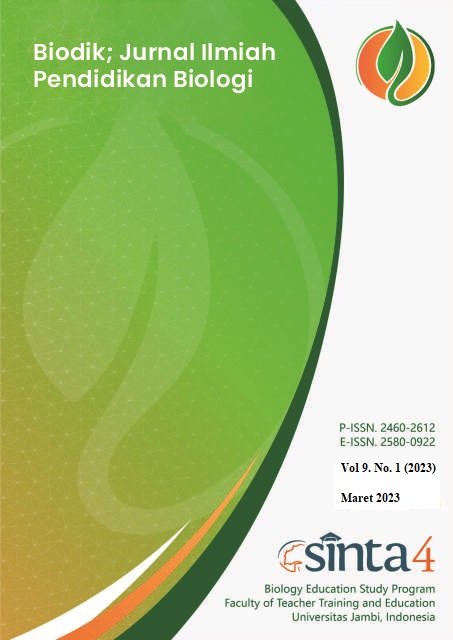Pengaruh Penerapan Model Pembelajaran Auditory Intellectually Repetition (AIR) dan Motivasi Terhadap Hasil Belajar Siswa Kelas VIII SMP Negeri 14 Kota Jambi
(The Effect of Applying the Auditory Intellectually Repetition (AIR) Learning Model and Motivation on Learning Outcomes of Class VIII Students of SMP Negeri 14 Jambi City)
DOI:
https://doi.org/10.22437/bio.v9i1.19314Abstract
This study aims to determine the effect of using the Auditory Intellectually Repetition (AIR) learning model and motivation on student learning outcomes. The type of research used was quasi-experimental research with a pretest-posttest control group design not randomly. The type of research design used is a 2x2 factorial design. The population in this study were students of grade VIII junior high school first semester. The samples used were class VIII A and VIII C, the samples were taken by purposive sampling technique. Learning achievement data was measured using a learning achievement test and motivational data was measured using a questionnaire. Data were analyzed using two way ANOVA. The results of the analysis show that the difference in post-test scores for the experimental class is higher than that for the control class. Based on the results of the study, it can be concluded that: 1) There is an effect of using the Auditory Intellectually Repetition (AIR) learning model on students' science learning outcomes. 2) There is a motivational influence on students' science learning outcomes. 3) There is no interaction between the use of the Auditory Intellectually Repetition (AIR) learning model and motivation on student learning outcomes.
Key words: Auditory Intellectually Repetition (AIR) learning model, motivation and learning outcomes
Â
ABSTRAK
Penelitian ini bertujuan untuk mengetahui pengaruh penggunaan model pembelajaran Auditory Intellectually Repetition (AIR) dan motivasi terhadap hasil belajar siswa. Jenis penelitian yang digunakan adalah penelitian eksperimen semu dengan desain penelitian pretest-postest grup kontrol tidak secara random. Jenis rancangan penelitian yang digunakan adalah desain factorial 2x2. Populasi pada penelitian ini adalah siswa kelas VIII SMP semester satu. Sampel yang digunakan adalah kelas VIII A dan VIII C, sampel diambil dengan teknik purposive sampling. Data prestasi belajar diukur dengan menggunakan tes prestasi belajar dan data motivasi diukur dengan menggunakan angket kuesioner. Data di analisis dengan menggunakan ANOVA dua jalur. Hasil analisis menunjukan bahwa selisih nilai post test untuk kelas eksperimen lebih tinggi dibandingkan kelas kontrol. Berdasarkan hasil penelitian maka dapat disimpulkan bahwa: 1) Terdapat pengaruh penggunaan model pembelajaran Auditory Intellectually Repetition (AIR) terhadap hasil belajar IPA siswa. 2) Terdapat pengaruh motivasi terhadap hasil belajar IPA siswa. 3) Tidak terdapat interaksi antara penggunaan model pembelajaran Auditory Intellectually Repetition (AIR) dan motivasi terhadap hasil belajar siswa.
Kata kunci: Model pembelajaran Auditory Intellectually Repetition (AIR), motivasi dan hasil Belajar
Downloads
References
Alawi, AM. (2019). Penerapan model pembelajaran auditory intellectually repetition (AIR). Skripsi. Surabaya: UIN Sunan Ampel Surabaya.
Arifin, Z. (2009). Evaluasi Pembelajaran. Jakarta: Renaja Rosdakarya.
Arikunto, S. (2014). Prosedur Penelitian Suatu Pendekatan Praktis, Jakarta: Rineka Cipta.
Bulu, M. Pengaruh model pembelajaran auditory intellectually repetition (AIR) berbantuan LKPD terhadap motivasi dan hasil belajar biologi peserta didik kelas X MIA SMAN 5 Denpasar tahun pelajaran 2019/2020. Jurnal educasi matematika dan Sains. Universitas PGRI Mahadewa Indonesia.
Dewi, N. K. A. K., & Rati, N. W. (2020). Pengaruh Model Pembelajaran ( AIR ) Berorientasi Tri Pramana Terhadap Motivasi Belajar dan Hasil Belajar IPA. Mimbar PGSD, 8(1), 100–110.
Djamarah, SB. (2013). Strategi Belajar Mengajar, Jakarta: PT Asdi Mahasatya.
Fatkhan, Pengertian dan langkah-langkah model pembelajaran auditory intellectually repetition. Diakses tanggal 14 Mei 2017. .https://fatkhan.web.id/pengertian- dan-langkah-langkah-model-pembelajaran-auditory-intellectually-repetition- air/
Fatmawati, A. (2014). Penerapan pendekatan auditory Intellectually Repetition (AIR) pada materi pertidaksamaan di kelas X-CSMAN 1 Kauman Tulangagung. Skripsi. Surabaya. Universitas Negeri Surabaya,.
Hamzah, B Uno (2011). Teori motivasi dan pengukurannya. Jakarta:Bumi Aksara.
Huda, M. (2013). Model-model pengajaran dan pembelajaran.Yokyakarta: Budi utama.
Jonathan, S. (2006). Metode Penelitian kualitatif dan kuantitatif : Yokyakarta:Graha Ilmu.
Margono. (2014). Metodelogi penelitian pendidikan. Jakarta:Rineka Cipta.
Mulyatiningsih, E. (2014). Metode penelitian terapan bidang pendidikan. Bandung:Elfabeta Bandung.
Oktaviani, S. (2020). Model-model pembelajaran. Yogyakarta:Budi Utama..
Purnamasari, 2013. Pengaruh model pembelajaran Auditory Intellectually Repetition (AIR) terhadap prestasi matematika pada materi aljabar kelas VII SMP Muhammadiyah 3 Jetis tahun ajaran 2013/2014. Jurnal riset pendidikan matematika 5(3): 1-10
Rusdi.(2020). Penelitian perlakuan pendidikan. Depok:PT Raja Grafindo Persada.. Sugiyono.(2018). Metode penelitian pendidikan kuantitatif, kualitatif, R&D. Sugiyono.(2019).Statistika untuk peneliti.Bandung:ElfabetaBandung. Bandung:Elfabeta Bandung
Sutiyani,I.(2017). Penerapan model pembelajaran Auditory Intellectually Repetition (AIR) pada materi sel terhadap hasil belajar peserta didik kelas XI SMA Negeri Jakenan. Skripsi Surabaya. UNNES.
Downloads
Published
How to Cite
Issue
Section
License
Copyright (c) 2023 Masitah, Sri Purwaningsih, Jodion Siburian

This work is licensed under a Creative Commons Attribution-NonCommercial-ShareAlike 4.0 International License.
Copyright Notice
Authors who publish with Biodik : Jurnal Ilmiah Pendidikan Biologi agree to the following terms:
- For all articles published in Biodik : Jurnal Ilmiah Pendidikan Biologi, copyright is retained by the authors and grant the journal right of first publication with the work simultaneously licensed under a Creative Commons Attribution-ShareAlike 4.0 International Licensethat allows others to share the work with an acknowledgment of the work's authorship and initial publication in this journal.
- Authors are able to enter into separate, additional contractual arrangements for the non-exclusive distribution of the journal's published version of the work (e.g., post it to an institutional repository or publish it in a book), with an acknowledgment of its initial publication in this journal.
- Authors are permitted and encouraged to post their work online (e.g., in institutional repositories or on their website) prior to and during the submission process, as it can lead to productive exchanges, as well as earlier and greater citation of published work (See The Effect of Open Access).
















